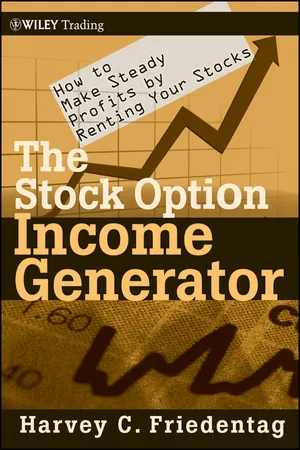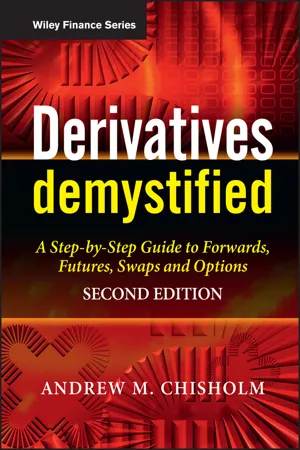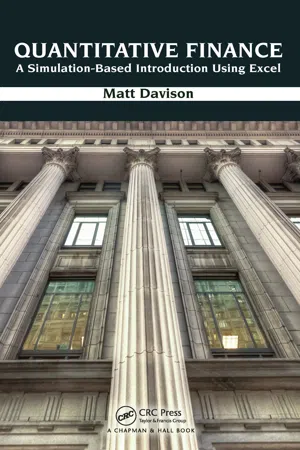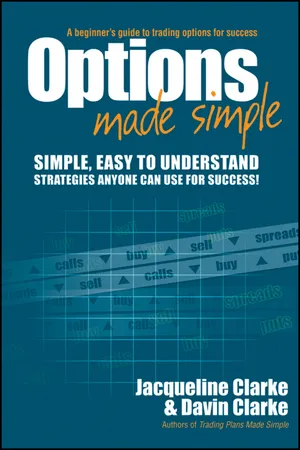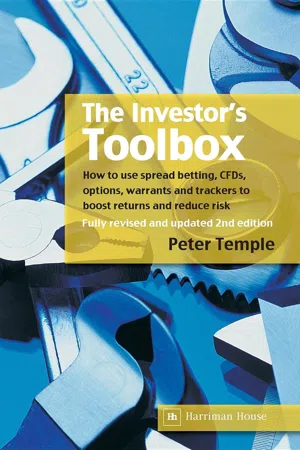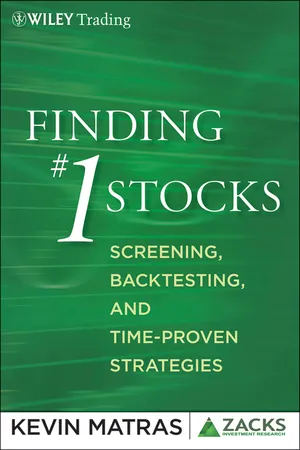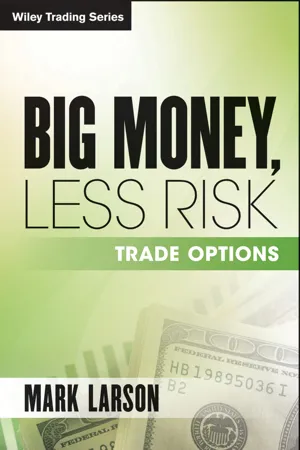Call Options
Call options give the holder the right, but not the obligation, to buy a specific quantity of an underlying asset at a predetermined price within a set timeframe. This provides the opportunity for potential profit if the market price of the asset rises above the predetermined price. Call options are commonly used in business to hedge against price fluctuations and to speculate on future price movements.
8 Key excerpts on "Call Options"
- eBook - ePub
The Stock Option Income Generator
How To Make Steady Profits by Renting Your Stocks
- Harvey C. Friedentag(Author)
- 2009(Publication Date)
- Wiley(Publisher)
...In stocks, those bids and offers are for shares of stock. In options, the bids and offers are for the right to buy or sell 100 shares (per option contract) of the underlying stock at a given price per share for a given period of time. HISTORY OF OPTIONS In the year 1694, put and Call Options were introduced in London, England. More than two and a half centuries later, put and Call Options continue to be an important addition to security dealings. Introduced into this country about a century ago, put and Call Options soon became the favorite speculative tool of the old-time Wolves of Wall Street. The conventional shied away from them, and to this day, many cast a prejudiced eye upon options. The ordinary investor used to regard dealing in puts and calls as a special, complicated maneuver, tinged with evil. About 40 years ago, when threatened with the stopping of option trading, the Put and Call Brokers and Dealers Association instituted rules and standards that resulted in a degree of respectability for put and Call Options. Since then, these stock options have become better understood and more widely used by investors to hedge against price movements, to protect unrealized profits, and to gain potential tax savings. Although the history of options extends over several centuries, it was not until 1973 that standardized, exchange-listed, and government-regulated options became available. In only a few years, these options almost displaced the limited trading in over-the-counter options. The options trading has become an indispensable tool for the securities industry. FUNCTION OF OPTIONS Standardized option contracts provide orderly, efficient, and liquid option markets. All stock option contracts are for 100 shares of the underlying stock. The strike price of an option is the specified share price at which the shares of stock will be bought if the holder exercises the option. Options are an extremely versatile investment tool...
- eBook - ePub
Derivatives Demystified
A Step-by-Step Guide to Forwards, Futures, Swaps and Options
- Andrew M. Chisholm(Author)
- 2011(Publication Date)
- Wiley(Publisher)
...8 Fundamentals of Options INTRODUCTION Chapter 1 explained that options on commodities such as rice, oil and grain have been in existence for many years. Options on financial assets are more recent, although they have expanded rapidly since the 1980s. This chapter introduces fundamental option concepts. It takes a ‘building block’ approach and describes the basic option strategies that are applied in different combinations in later chapters. It explains the key ‘jargon’ expressions used in the options market - call and put; strike price; expiry date; premium; intrinsic and time value; in-, at- and out-of-the-money; break-even point; and so on. These concepts are illustrated with practical examples. The chapter shows the payoff profiles for four basic option strategies - long a call, short a call, long a put, short a put. These are compared with the profits and losses achieved by buying or selling underlying shares. DEFINITIONS The buyer of a standard or ‘vanilla’ financial option contract has the right but not the obligation: • to buy (call option) or to sell (put option); • an agreed amount of a specified financial asset, called the underlying ; • at a specified price, called the exercise or strike price; • on or by a specified future date, called the expiry date. For this right the buyer of an option pays an up-front fee called the premium to the writer of the contract. This is the most money the buyer can ever lose on the deal. On the other hand the writer of an option can face virtually unlimited losses (unless a hedge is put in place). This is because it is the buyer who decides whether to exercise (take up) the option. Exchange-traded options are mainly standardized, but settlement is guaranteed by the clearing house associated with the exchange. Over-the-counter (OTC) option contracts are agreed directly between two parties, one of which is normally a bank or securities trading house...
- eBook - ePub
Quantitative Finance
A Simulation-Based Introduction Using Excel
- Matt Davison(Author)
- 2014(Publication Date)
- Chapman and Hall/CRC(Publisher)
...The seller of an option, also known as the “option writer,” is said to be “short” the option, even though they have not borrowed the option security for later resale but instead have actually created the option by selling it. The amount charged for the option is known as the “option premium.” At any given time, an option is said to be “out of the money” if, were this to be allowed, it would not be rational to exercise it today. On the other hand, if any option could be exercised today for a nonzero payout, it is said to be “in the money.” As such, if the stock price is above the strike price of a call option, that option is in the money, and so on. 16.3 Uses for Put and Call Options It is perhaps easiest to see the value of buying a put option. Buying a put option is like buying “stock price insurance.” For the cost of the option premium, the holder of the put option is immunized against a decrease in the stock price below the strike of the option. Used in this way, it is clear that the options purchaser is decreasing their downside risk in exchange for a reduction (by the amount of the premium paid) in their upside return. A call buyer can use an option in a similar risk-averse way. If she believes that the stock price is going to rise above the strike price before the expiry date, she can purchase a call. Then she will profit by the amount of the rise above the strike, less the option premium paid. However, her loss in the event that their “market call” is wrong is limited to the premium paid. However, a speculator with the same “view” on the future direction of stock prices can also use Call Options in a different way—not as a tool to profit from their view with limited risk, but as a tool to greatly increase his prospective profit with the same level of downside risk. To see this, we need some semiquantitative results...
- eBook - ePub
Quantum Trading
Using Principles of Modern Physics to Forecast the Financial Markets
- Fabio Oreste(Author)
- 2011(Publication Date)
- Wiley(Publisher)
...Black and Scholes hadn't yet discovered their option pricing models (they weren't even born yet), and so, in the beginning there was a fixed price for both calls and puts. It wasn't important that 15 or 30 days were left until the expiration day of a period: the price was always the same. Option buyers and sellers didn't have any models to understand if an option price was fair or not. They had only a fixed price, which caused fewer problems than the ones experienced by a professional options trader today. Finally, in 1973, a stock exchange was created in Chicago where many stock options were listed. Prices were clear and certain, and the transactions were regulated. But at that early stage only Call Options were listed. Put options weren't available yet; traders needed to wait a few years before having the complete option system that we have today. At that time traders used synthetic positions to simulate a put, obtained by selling short the stock, and simultaneously purchasing a call. Options Characteristics You can create an option on whatever is exchanged between different counterparts. If the option's underlying is listed in a regulated market, then the option is a standard contract with an official quotation. You have two kinds of options: calls and puts. A call buyer purchases the right to take advantage of a rise in the underlying. A put buyer bets on the decline of the option's underlying price. Consequently we will review the definition of an option we already saw at the beginning of the chapter. An equity option is a contract that conveys to its holder the right, but not the obligation, to buy (in the case of a call) or sell (in the case of a put) shares of the underlying security at a specified price (the strike price), on or before a given date (expiration day). After this given date, the option ceases to exist...
- eBook - ePub
Options Made Simple
A Beginner's Guide to Trading Options for Success
- Jacqueline Clarke, Davin Clarke(Authors)
- 2011(Publication Date)
- Wiley(Publisher)
...available • find the least expensive option that meets your criteria above and will generate a sufficient return on investment. Chapter summary • When buying Call Options, you are speculating on an increase in price of the underlying stock. • Buying Call Options is a popular strategy as it is easily understood and in line with buying stocks for growth. • If your call option strategy is successful, your percentage returns can be immense. • Your risk in buying Call Options is limited to the premium you pay for the call option. • Time is a significant factor in a call option strategy due to the impact of time decay on the value of your option and the need for the underlying stock price to increase sufficiently before the expiry date. • There are several reasons why you might consider buying Call Options as your trading strategy. These include the following: • gain leverage • limit your risk • delay a stock purchase • speculate for profit. • Buying Call Options provides you with leverage compared with investing in the underlying stock directly. • Buying Call Options can limit your risk as your loss is always limited to the premium you paid for the Call Options. When buying the stock directly, you are exposed to all falls in value, however severe. • Buying Call Options can enable you to delay a planned purchase of the underlying stock but set the price now. • You can buy Call Options as a strategy to simply speculate on generating a short-term profit on your option trade. • The biggest disadvantage to call option buyers is time. Any strategy involving buying Call Options must be successful before the expiry date of the option. • Call option buyers must also account for time decay in their option strategy. • In selecting your option, you need to ensure the key components of strike price and expiry date match your strategy. • You want to buy the option that has the most advantageous strike price and expiry date and the lowest option premium....
- eBook - ePub
The Investor's Toolbox
How to use spread betting, CFDs, options, warrants and trackers to boost returns and reduce risk
- Peter Temple(Author)
- 2012(Publication Date)
- Harriman House(Publisher)
...First, “An option holder has the right, but not the obligation, to buy (or sell). . .” In other words you have the right to choose to exercise your option if the terms look attractive. But because you have no obligation to use the option, you can choose to forfeit the small upfront premium you paid for it if exercising is not worth your while. Simply let the option lapse: end of story. But there is another element to this choice. You can also choose to sell your option in the market at a profit rather than undergo the process of exercising it. Or you can sell it some time before expiry even if you can’t exercise it at a profit. You may be able to recoup a part of the upfront cost of the option even if you have to sell it at a loss. One thing is certain: if the option can’t be exercised at a profit, when it expires it will have no value. Calls and Puts The next question is why, in the definition I used above, did I use the phrase option to buy (or sell) ? The answer is simple. Options come in two flavours – Call Options and put options: A call option is an option to buy at a fixed price for a known period of time. A put option is an option to sell at a fixed price for a known period of time. The fixed price at which you can buy (or sell, in the case of a put) the shares during the life of the option is known as the exercise price, or strike price. There are a couple of things that follow from this. One is that if the price of the underlying on which the option is based moves in the right direction, the value of the option will rise. Let’s say you have an option to buy 1,000 Vodafone shares at 100p for the next six months. If Vodafone shares rise from 100p to 120p, it follows that your call option at 100p would become more valuable. In theory you could exercise the option, take delivery of the shares at a price of 100p and then sell them immediately for 120p...
- eBook - ePub
Finding #1 Stocks
Screening, Backtesting and Time-Proven Strategies
- Kevin Matras(Author)
- 2011(Publication Date)
- Wiley(Publisher)
...More and more people are now including options in their investments as a smart way to get ahead of the market. Most people know that options offer many advantages, not the least of which is a guaranteed limited risk when buying calls and puts. They also offer a great deal of leverage while using only a fraction of the money you would normally have to put up to get into the actual stocks themselves. But as we said at the top, one of the best advantages of options is flexibility: the ability to make money if a stock goes up, down, or sideways, as well as to simultaneously provide ways to reduce your risk and increase your returns. Before we go over some of the different strategies, let me first go over a few definitions. Call Option: A call option gives the buyer the right (but not the obligation) to buy a stock (typically 100 shares) at a certain price within a set period of time. Put Option: A put option gives the buyer the right (but not the obligation) to sell a stock (100 shares) at a certain price within a set period of time. Premium: The amount paid (if buying) or collected (if writing) for the option. Strike Price: The price on an option contract at which you can exercise your right to buy or sell the stock. In-the-Money (ITM): For a call option, an in-the-money option is a strike price below the current price of the stock. It’s said to be in-the-money because it has intrinsic value. If a stock was trading at $50 a share, a call option with a strike price of $45 would be in-the-money. For a put option, it’s a strike price above the current price of the stock. If a stock was trading at $50, a put option with a strike price of $55 would be in-the money. At-the-Money (ATM): For both a call and a put option, it’s a strike price that’s at the same current price of the stock. Out-of-the-Money (OTM): For a call option, it’s a strike price above the current price of the stock...
- eBook - ePub
Big Money, Less Risk
Trade Options
- Mark Larson(Author)
- 2012(Publication Date)
- Wiley(Publisher)
...Chapter Four Making the Call: Buying Call Options IN THIS CHAPTER Identifying bullish trends Purchasing time Making a few trades for big returns Let’s review: the purchase of a call option is the right (not the obligation) to purchase the underlying stock for a certain price known as the strike price, on or before a certain date (expiration date). Knowing this, we’ll be looking for bullish stocks in uptrending markets, selecting the best available call option for purchase, and selling the option for a profit if we were right. If not, we need to be willing to sell the option at a loss if the stock goes down instead of up. In many ways this strategy is the same as real estate investment during good times, such 2000 though 2005. As an example, if we were to purchase a June $70 call option for $5 and the stock moved to $80, the $70 strike price would have a minimum value of $10; so, instead of buying the stock for $70 per share when it is worth $80 per share, we would sell the option for $10 to close out the trade. We would make $5 per share or 100% return on our option investment of $5. Think Real Estate Buying Call Options is similar to a real estate lease option; you’re willing to sell your home, and I’m willing to purchase it. So, I purchase a contract giving me the right to purchase your home for a certain price on or before a certain date. I pay you a premium for this option to purchase. Several important parts of this contract are the time frame (expiration date) and the price I agree to pay for the home (strike price). Let’s say I was to give you $3,000 with 60 days to buy your house for $400,000. I now have three choices and must do one of the three before the expiration date. 1. I exercise my right and pay you $400,000 before the expiration date and I own the house (or the stock). 2. I don’t exercise my right and allow you to keep the house and my option investment of $3,000. My maximum loss is $3,000. 3...
